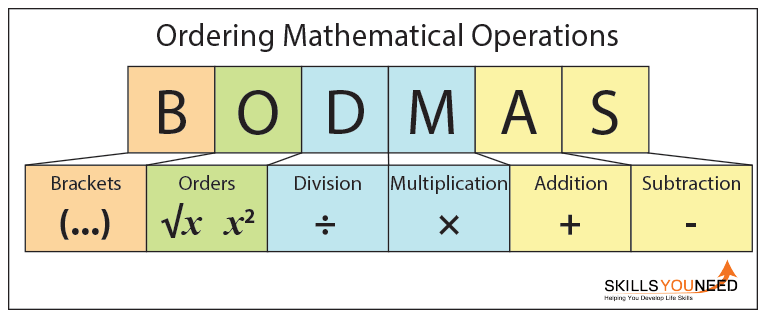Dear Candidate:
Purpose : To prepare for written exam of SBI JUNIOR ASSOCIATES (CLERK)/SBI PO
Purpose : To prepare for written exam of SBI JUNIOR ASSOCIATES (CLERK)/SBI PO
Now there are more than 100 post on this subject in this link, you can view all previous posts also .

Rules of Ordering in Mathematics - BODMAS

BODMAS is a useful acronym that lets you know which order to solve mathematical problems (or sums). It's important that you follow the rules of BODMAS as without it your answers can be wrong.
The BODMAS acronym is for:
- Brackets (parts of a calculation inside brackets always come first).
- Orders (numbers involving powers or square roots).
- Division.
- Multiplication.
- Addition.
- Subtraction.
Brackets
Start with anything inside brackets, going from left to right.
Example:
4 × (3 + 2) = ?
You need to do the operation, or sum, inside the brackets first, 3 + 2, then multiply the answer by 4.
3 + 2 = 5.
4 × 5 = 20
4 × 5 = 20
If you ignored the brackets and did the sum 4 × 3 + 2 you would get 14. You can see how the brackets make a difference to the answer.
Orders
Do anything involving a power or a square root next (these are also known as orders), again working from left to right if there is more than one.
Example:
32 + 5 = ?
You need to do the power sum first, before you can add 5.
32 = 3 × 3 = 9
9 + 5 = 14
9 + 5 = 14
Division and Multiplication
Once you have done any parts of the sum involving brackets or powers the next step is division and multiplication.
Multiplication and division rank equally, so you go from left to right in the sum, doing each operation in the order in which it appears.
Example:
4 × 5 ÷ 2 + 7 = ?
You need to do division and multiplication first, but you have one of each.
Start from the left and work across to the right, which means that you start with 4 × 5 = 20. Then do the division, 20 ÷ 2 = 10.
Only then do you move to the addition: 10 + 7 = 17. The answer is 17.
See our pages: Multiplication and Division for more.
Addition and Subtraction
The final step is to calculate any addition or subtraction. Again, subtraction and addition rank equally, and you simply move from left to right.
Example:
4 + 6 - 7 + 3 = ?
You simply start on the left and work your way across.
4 + 6 = 10
10 - 7 = 3
3 + 3 = 6
The answer is 6.
10 - 7 = 3
3 + 3 = 6
The answer is 6.
(Ref: http://www.skillsyouneed.com/)
For written exam/ interview guidance , you may contact:
ANIL AGGARWAL SIR ( P.O. 1982 BATCH)
EX CHIEF MANGER ,PUNJAB NATIONAL BANK.
Mobile: +91 9811340788
E-mail ID: anilakshita@yahoo.co.in
Office: Flat #49, Trilok Apartments, Patparganj, I.P. Extension, Delhi-110092.
Follow us at:
Facebook Page: https://www.facebook.com/AnilAggarwalJobguidancehub
Website: http://bankinterview.in/
No comments:
Post a Comment